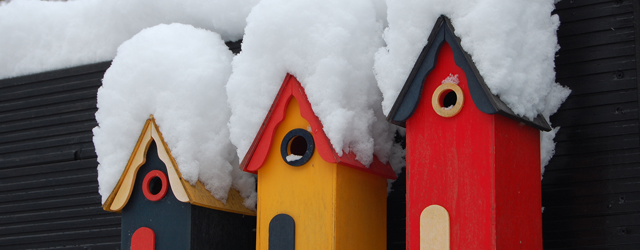Nothing says festive like a tablecloth of snow draped over roofs and tree-tops. Yet, despite its magical and fluffy appearance, snow, in particular its weight, poses a serious hazard to our homes, cars and businesses. But how many of us seriously consider the possibility of roof collapse when we awake to several feet of snow on our lawn?
How much snow your roof can withstand will depend on many factors, such as age and composition. The roofs of barns, sheds, out-buildings and conservatories may not be as strong as your main building, and caution is needed when inspecting any possible bowing.
The shape of your roof is a critical factor in determining the effects of snow load on your property. A steep roof pitch affects weight distribution and snow will usually fall back onto the ground of its own accord. Of course, a flat roof will hold snow without displacement or disbursement which poses a greater risk of roof collapse.
Wind direction can also affect the weight of snow on your roof: snow drifts which can leave certain areas of your roof bearing more snow than others, a particular problem if you’ve experienced a few days of snowfall. Conditions can be further exacerbated when rain follows heavy snow, as a snow laden roof will absorb rain like a dry sponge, contributing further to the pressure and weight.
If you do wake to an unexpected delivery of snow one morning, which exceeds a foot, try to remove as much snow as safely as possible, but do not climb on your roof! Try and access as much of the snow as possible with a rake, broom or specialist snow rake. If you’re unable to safely reach the roof, just clearing the overhangs will help reduce excess weight. And don’t worry if you’re unable to clear all the snow from your roof; any reduction is going to make a difference to the overall load.
Often, before a roof collapses due to the excessive weight of snow and ice, your property will exhibit some of the following signs:
-
- Visual deformation of the roof.
- Cracked or split wooden structural elements of the roof framework.
- Doors and windows that suddenly become difficult to open or close.
- Creaking or crackling noises.
- Separation of ceiling joists and beams.
- Signs of new movement in flashing around chimneys, door trims, ceilings and staircases.
Whilst preemptive measures should be taken to prevent structural damage to your property following a snow dump, such as cleaning debris away from gulleys, gutters and drains, and replacing broken roof tiles, flashing and cladding, the following steps should be taken after periods of heavy snowfall, to reduce the likelihood of roof collapse:
- Try to keep roofs, gutters, downspouts and drains clear of ice so water can freely drain away.
- When clearing snow from your driveway or footpath, do not deposit against the foot of any downspouts as this may interfere with effective drainage.
- Safely, chip and channel any ice dams to ensure water can flow freely.
- Be watchful for signs of stress and deflection of the roof and wall structure such as cracking, splitting or twisting, particularly in trusses, joists and beams.
- Roof failures can occur at the exterior wall connections particularly in buildings with flat roofs, so it is vital to check the connections for signs of cracking or twisting.
- Be alert to any unusual sounds emanating from the building such as creaking from the room.
- Specialist advice should be sought if considering the removal of snow from roofs.
- Keep the attic well ventilated to reduce the build-up of snow and formation of ice dams.
Whilst in the UK, heavy, prolonged snow is extremely rate, the potential exists with climate change to experience such conditions more frequently. By following the tips above, hopefully you will avoid or mitigate any future damage to your property.
*Extracts of this blog by permission of Aviva.

